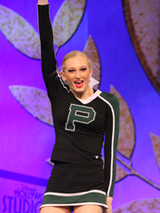Overcoming a Crooked Spine — Spine Surgery for Scoliosis Takes Aspiring Cheerleader from the Sidelines to Stardom
Overcoming a Crooked Spine — Spine Surgery for Scoliosis Takes Aspiring Cheerleader from the Sidelines to Stardom
Tori has been jumping, leaping and flipping for as long as she can remember. She began gymnastics at age 5 and was a natural from the start.

When she entered junior high at her local school about 30 miles outside of Philadelphia, a new outlet for her love of acrobatics emerged: cheerleading. But shortly after Tori discovered cheerleading, her pediatrician made a discovery as well. During a routine physical exam, the pediatrician noticed a curvature towards the top of Tori’s spine, a telltale sign of scoliosis, a deformity that causes the spine to curve unnaturally.
The pediatrician referred Tori to an orthopedic specialist at a specialty care center near her home that is part of the Children’s Hospital of Philadelphia (CHOP) Care Network. The CHOP Care Network provides convenient access to expert primary and specialty care for children throughout the Philadelphia area.
Tori had checkups every few months to monitor the progress of the curve, and the specialist taught her stretching exercises to help correct some of the imbalances caused by the scoliosis. But as Tori’s body grew, the curve in her back increased and the exercises grew less effective.
The specialist had Tori fitted for a back brace in an effort to slow the progress of the curve, in an effort to avoid surgery. But if surgery became necessary down the road, Tori had access to some of the top pediatric orthopedic surgeons in the nation at The Children’s Hospital of Philadelphia.
Adjusting to the brace was a struggle for Tori. It was like a straightjacket made of hard plastic, tightly fastened around her body — from the chest to below the hips – using Velcro straps. Being a teenager is hard enough. Wearing the brace and standing out from peers was a fate worse than death.
But Tori wore the back brace 20 hours a day. Its edges pinched and dug into her skin, especially at night. She only took the brace off for gymnastics, cheerleading and softball practice. At school, she wore it under her clothes so no one would see it. Despite her dislike of the brace, Tori couldn’t deny that she felt much better with it on.
The brace did its job for three years. But at age 14, the curve in Tori’s back increased from 35 percent to 55 percent in just a matter of months, and she started to notice sharp pain and shortness of breath when she did certain gymnastics movements.
“The curve in her spine had pushed her right shoulder blade to the left and was actually pushing her ribs into her lungs and heart,” says her mom, Donna.
The specialist referred Tori to John M. Flynn, MD, a nationally recognized spine surgeon and chief of CHOP’s Division of Orthopedics. Dr. Flynn recommended posterior spinal fusion surgery, in which the curve of the spine is corrected and then fused into place, anchored by steel rods. Dr. Flynn has more than 15 years of experience performing this surgery.
The surgery would correct Tori’s scoliosis permanently, which relieved both Tori and her parents. But in doing so, the procedure would make the upper portion of Tori’s back permanently rigid. Tori’s parents thought for sure that meant the end of her gymnastics and cheerleading career. But Dr. Flynn vowed that after surgery, the CHOP team would work to get Tori as close to her pre-surgery activity level as possible.
Tori recalls feeling excited and hopeful. She timed the surgery so that she would have enough time to recover and still make it to cheer camp.
“I knew the surgery would help make me better in the future,” she says.
She was right. Less than six months after surgery, Tori was well enough for cheer camp.
“Tori had crazy flexibility, even with the scoliosis, before the surgery,” says her dad, Greg. “She lost some of that flexibility and had to learn to do stunts a little differently because her back wasn’t able to bend quite the same. But we were thrilled that she was able to get back and do the things she did before.”

Now, two years after her surgery, Tori has led her cheerleading squad to back-to-back top 10 or better finishes in district, regional, state and national competitions. She has no back pain or breathing issues, and no activity restrictions. She plans to do competitive cheerleading in college.
“The CHOP team was fantastic,” says her mom. “If it weren’t for them she would have been severely deformed and would have had significant back issues.”